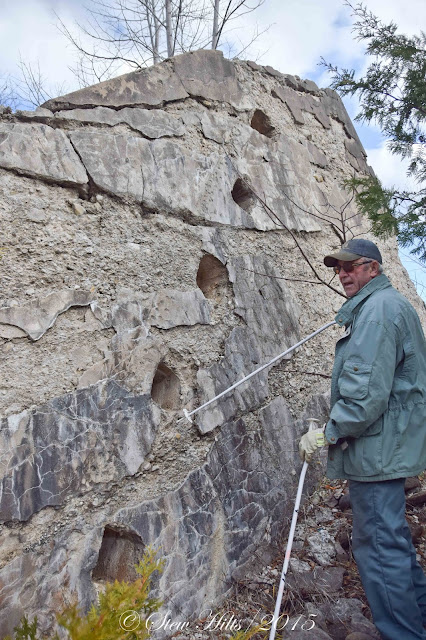Although John Moir's connection with Trout Hollow is what intrigues me the most, there was another important industrial development in the Hollow that is quite fascinating. This is the Georgian Bay Milling and Power Company which generated hydro for street lights in Meaford from 1902 to 1923 before Ontario Hydro's government support drove all the small power plants like this one into bankruptcy (and did spread the benefits of electricity to homeowners, a big step forward).
Here you can see the two remnants of the dam that crossed the Bighead River, big concrete abutments on each side. The Trouts' sawmill was just out of sight behind the dam remnant on the right, on the far shore.Here my friend Glen was pointing out the slots for timbers that were part of the control structure.
Beyond this was a high rock embankment that we walked along. It controlled a holding pond on the left where water was pooled before it ran down to the turbines.
The water emerged from this gap in the berm.
From the other side it's a huge S-bend, five feet in diameter. This fed water into the powerhouse where it turned the turbines and generated the hydro.
There isn't much left of the powerhouse today, just a few leaning cement walls, looking strangely out-of-place in the middle of the forest.
The Trout Hollow Trail continues downstream into the town of Meaford, and you get some great views of the river from the bluffs. The donation of Trout Hollow by the Knight family is truly a big story for conservation in this part of Grey County.
I was perplexed though that the donation story on the Escarpment Biosphere Conservancy's website focuses on the power house story and only makes passing mention of Muir. You would think that John Muir's connection with Trout Hollow was more significant for a 'Biosphere Conservancy'.










It's remarkable how nature reclaims a spot.
ReplyDeleteBeautiful pictures. Ditto to what William said!
ReplyDeleteThe cement wall is rather haunting.
ReplyDeleteThe walkway in my pic was not like that 50 years ago. It is the walkway that ran from St George to the front campus beside what was then the U of T bookstore. It is now thew Alumni House. I think you were at U of T around the same time as me.
I was watching an episode of "University Challenge" (a quiz for young eggheads) the other evening and a question was asked about a conservationist who was born in southern Scotland and instrumental in the founding of America's National Parks. Not only could these young intellectuals not come up with a name but they showed no sign of recognition when the answer was revealed. There's still a long way to go.
ReplyDeleteYou gave us a good virtual tour with some good pics and commentary.
ReplyDeleteWhat a great area for a walk and some exploration of the remnants of the power plant. I love to come across items we know nothing about and speculate what it was for. Research sometimes ends the speculation. However, like much on the island, you just have to mention it to the right person.
ReplyDeleteThis comment has been removed by a blog administrator.
ReplyDeleteInteresting to see your photographs and learn more about this area.
ReplyDeleteAll the best Jan
Oh if only those old leaning concrete walls could talk. I like exploring around old ruins like that and speculating how it all may have worked at one time.
ReplyDelete"You would think that John Muir's connection with Trout Hollow was more significant for a 'Biosphere Conservancy'."
ReplyDeleteYes you would.
an interesting post...i love the first picture!!
ReplyDeleteI did a bit of reading on the web and nothing I read mentioned Muir's connection or time spent in Canada. So I guess it is not surprising his connection has been mostly overlooked.
ReplyDeleteI really like seeing history no matter how far back that it extends. It is a fascinating past with the structures still showing.
ReplyDelete